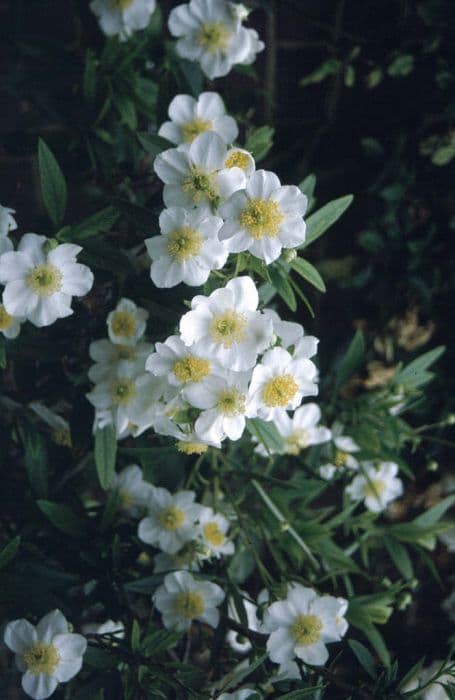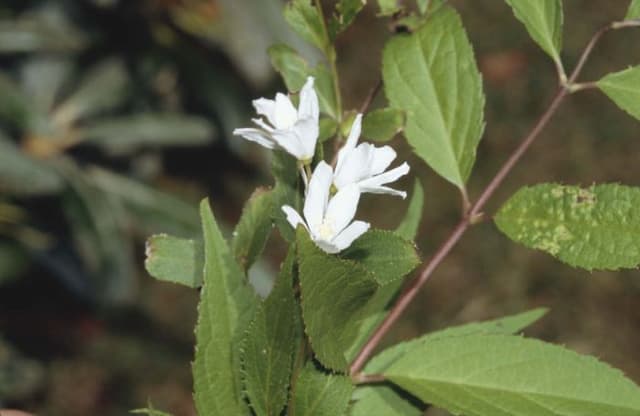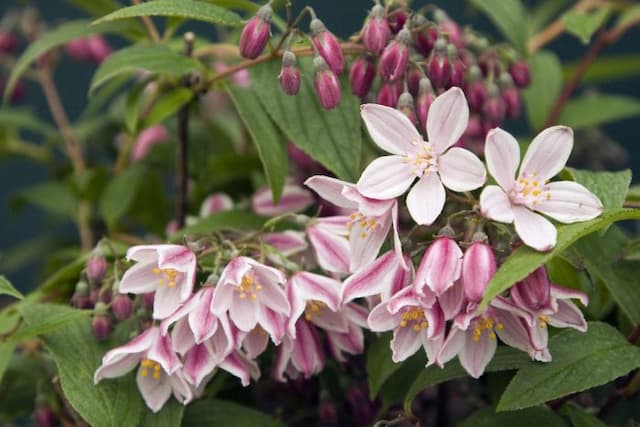Lacecap Hydrangea Hydrangea macrophylla 'Mariesii Lilacina' (L)

ABOUT
The 'Mariesii Lilacina' is known commonly as Lacecap Hydrangea and is prized for its distinctive and elegant bloom arrangement. This plant features a captivating flower head that is characterized by a flat or slightly rounded shape. The blossoms are a two-tiered combination with small, fertile flowers clustered at the center, surrounded by a ring of larger, showy sterile flowers that give the appearance of delicate lace. The large flowers are typically a soft, lilac color with subtle blue or pink tones that can vary depending on the soil acidity. The heart-shaped leaves of this Lacecap Hydrangea are a deep green, creating a lush backdrop for the pastel blooms. The foliage can also take on a reddish or purplish tint in the fall, adding to its ornamental appeal. This hydrangea variety has sturdy stems that hold both the leaves and flower heads, which emerge in late spring to early summer and can add a touch of romantic flair to the garden. These characteristics make the Lacecap Hydrangea 'Mariesii Lilacina' a visually appealing plant that captures the attention of onlookers.
About this plant
 Names
NamesFamily
Hydrangeaceae.
Synonyms
Bigleaf Hydrangea, French Hydrangea, Lacecap Hydrangea, Mophead Hydrangea, Penny Mac, Hortensia.
Common names
Hydrangea macrophylla 'Mariesii Lilacina'.
 Toxicity
ToxicityTo humans
Hydrangea, specifically Hydrangea macrophylla, contains compounds that can be toxic if ingested. The plant has cyanogenic glycosides, which can release cyanide when chewed or digested. Symptoms of poisoning may include stomach upset, nausea, vomiting, and diarrhea. In severe cases, ingestion can lead to more serious symptoms such as dizziness, difficulty breathing, and convulsions. It is generally recommended to avoid eating any parts of this plant.
To pets
Hydrangea can be toxic to pets such as cats and dogs if ingested. The plant contains cyanogenic glycosides which can break down into cyanide in the body. Symptoms of hydrangea poisoning in pets may include vomiting, diarrhea, lethargy, and depression. In severe cases, ingestion can lead to increased heart rate, hyperthermia, and even seizures. It is important to prevent pets from chewing on or eating any part of the hydrangea plant.
 Characteristics
CharacteristicsLife cycle
Perennials
Foliage type
Deciduous
Color of leaves
Green
Flower color
Lilac
Height
4 feet (1.22 meters)
Spread
4 feet (1.22 meters)
Plant type
Shrub
Hardiness zones
6
Native area
Japan
Benefits
 General Benefits
General Benefits- Visual Appeal: The Hydrangea macrophylla, also known as Bigleaf Hydrangea, produces beautiful large, lilac-colored blooms that enhance the aesthetic of gardens and landscapes.
- Seasonal Interest: With its vibrant flowers, the Bigleaf Hydrangea provides visual interest from late spring to early autumn, with peak blooming in the summer months.
- Versatile Landscaping: It is well-suited for various landscaping designs, including borders, as a focal point, or in mass planting, offering flexibility in garden planning.
- Pollinator Attraction: The flowers are attractive to pollinators like bees and butterflies, helping to support local ecosystems and biodiversity.
- Shade Tolerance: This variety of Hydrangea can tolerate partial shade, making it suitable for planting under trees or in areas with filtered sunlight.
- Soil pH Indicator: The flower color can indicate the pH level of the soil, with blue flowers in acidic soil and pink in alkaline, serving as a natural pH indicator for gardeners.
- Cultural Significance: Hydrangeas have various meanings in different cultures, often symbolizing grace, beauty, and abundance, adding symbolic value to the garden.
 Medical Properties
Medical PropertiesThis plant is not used for medical purposes.
 Air-purifying Qualities
Air-purifying QualitiesThis plant is not specifically known for air purifying qualities.
 Other Uses
Other Uses- Hydrangeas can be used as a natural pH indicator for soil. By observing the color change of the blooms from pink to blue or vice versa, one can determine the acidity or alkalinity of the soil.
- These plants can be utilized in art projects, such as pressing the colorful flowers for decorative purposes or using them in dried flower arrangements.
- The wood of mature hydrangea shrubs is sturdy and can be carved into small objects or used in woodworking as inlay details for its interesting patterns.
- Hydrangea leaves can be used in the fermentation process to create a type of sweet tea in some cultures, although this is not a common practice and should be done with caution.
- The vibrant flowers of hydrangeas can be used as a natural dye for fabric, yielding colors ranging from purples to blues depending on the mordants used.
- The large, beautiful blooms of hydrangeas are often used in the fashion industry for inspiration in design, ranging from patterns for textiles to color palettes for collections.
- In some cultures, hydrangeas are associated with certain emotions or messages, such as apology or gratitude, and are used in social rituals or ceremonies accordingly.
- Gardeners use cut hydrangea flowers to create visually appealing water features by floating them in bowls or ponds as a decorative element.
- Educationally, hydrangeas can be used as a teaching tool in horticulture classes to explain topics like macrophylla pruning techniques, breeding for color variation, and propagation methods.
- In landscaping, dried hydrangea flowers can be utilized as a natural mulch or ground cover, which gradually breaks down and enriches the soil with organic matter.
Interesting Facts
 Feng Shui
Feng ShuiThe Hydrangea is not used in Feng Shui practice.
 Zodiac Sign Compitability
Zodiac Sign CompitabilityThe Hydrangea is not used in astrology practice.
 Plant Symbolism
Plant Symbolism- Understanding: Hydrangeas often symbolize a deep understanding between two people, reflecting the various layers and depth of the flowers' arrangement.
- Heartfelt Emotions: The lushness and abundant clusters of the flowers represent the fullness of emotion that can be shared in human relationships.
- Gratitude: Giving a hydrangea can be a way of saying "thank you" for being understood. It's a common token of appreciation.
- Apology: In some contexts, hydrangeas may convey a sincere apology, perhaps due to the flower's association with frigidity and boastfulness in certain cultures.
- Beauty: The considerable size and beauty of the hydrangea's blooms are often associated with vanity and boastfulness, but they can also signify the beauty of nature and harmony.
- Fragility: Despite their large blooms, hydrangeas can wilt quickly, representing the fragility of emotions and the importance of care in relationships.
 Water
WaterFor Lacecap Hydrangeas, which is a common name for Hydrangea macrophylla varieties including 'Mariesii Lilacina', it's essential to maintain moist but well-draining soil. Water these hydrangeas deeply once a week, providing about 1 gallon of water per plant, especially during dry spells. During periods of extreme heat or drought, check the soil moisture more frequently and increase watering as needed to ensure the soil doesn't dry out, but avoid waterlogging. In the fall, reduce watering to help prepare the plants for dormancy. Remember to water directly at the base of the plant to keep moisture off the leaves and flowers.
 Light
LightLacecap Hydrangeas prefer a location with morning sun and afternoon shade, which helps protect the blooms from intense midday heat. Ideally, provide these hydrangeas with about 4 to 6 hours of filtered sunlight per day, which can be achieved by planting them in a spot that gets dappled shade under a canopy of deciduous trees or on the east side of a building.
 Temperature
TemperatureLacecap Hydrangeas thrive in a temperature range between 60°F and 80°F, making them suitable for most temperate climates. They can tolerate minimum temperatures down to around 20°F; however, winter protection may be needed to prevent frost damage. The optimal growth temperature for 'Mariesii Lilacina' occurs within the 65°F to 75°F range, where the plant can flourish without stress.
 Pruning
PruningLacecap Hydrangeas benefit from pruning to remove dead wood and to shape the plant, typically done in late winter or early spring. Since 'Mariesii Lilacina' flowers on old wood, be cautious not to remove stems that will produce the current year's blooms. Prune immediately after flowering if needed to encourage vigor and maintain a desirable size, but avoid extensive pruning late in the season.
 Cleaning
CleaningAs needed
 Soil
SoilLacecap Hydrangeas require well-drained, moist soil rich in organic matter. For the 'Mariesii Lilacina' variety, a soil pH of around 5.5 to 6.5 is ideal as it encourages the lilac-blue hue of the flowers. A good mix would include garden soil, compost, peat moss, and perlite to ensure proper drainage and fertility.
 Repotting
RepottingLacecap Hydrangeas, such as 'Mariesii Lilacina', should be repotted every 2-3 years. The best time to repot is during late winter or early spring, prior to the onset of the growing season. Ensure the new pot is only slightly larger than the old one to avoid waterlogging.
 Humidity & Misting
Humidity & MistingLacecap Hydrangeas thrive in an environment with high humidity, ideally between 60-70%. 'Mariesii Lilacina' benefits from regular misting to maintain the required humidity levels, especially when grown indoors or in drier climates.
 Suitable locations
Suitable locationsIndoor
Place Lacecap Hydrangea in bright, indirect light away from drafts.
Outdoor
Plant in morning sun, afternoon shade, and shelter from strong winds.
Hardiness zone
6-9 USDA
 Life cycle
Life cycleHydrangea macrophylla 'Mariesii Lilacina', commonly known as Lacecap Hydrangea, begins its life cycle with seed germination, which typically occurs in spring when soil temperature and moisture levels are suitable for growth. Following germination, the seedling stage involves the development of the first true leaves and establishment of a root system. As the plant enters the vegetative growth stage, it develops a woody stem, more complex root system, and larger leaves, preparing for flowering. During the flowering stage, which usually occurs in early to mid-summer, the Lacecap Hydrangea produces distinctive flat flower clusters with small fertile florets surrounded by larger sterile florets, often exhibiting shades of blue or pink depending on soil pH. After pollination and fertilization, the plant develops seeds within the spent flowers as it progresses into the senescence stage, preparing for dormancy during the winter months. The plant can then survive winter dormancy, re-emerging and repeating the cycle in the following spring.
 Propogation
PropogationPropogation time
Early spring
Hydrangea macrophylla 'Mariesii Lilacina', commonly known as Lacecap Hydrangea, is commonly propagated by softwood cuttings taken in late spring or early summer when the plant’s new growth is still tender and flexible. To do this, a gardener should select a healthy branch and cut a 4 to 6 inch (10 to 15 cm) portion that includes at least two pairs of leaves. The lower leaves are removed, and the cut end is often dipped in rooting hormone to improve the chances of root development. This prepared cutting is then inserted into a pot filled with moistened potting mix, sand, or vermiculite. It’s crucial to keep the cuttings under conditions of high humidity and indirect light until roots develop, which typically takes 2 to 4 weeks. Once rooted, the young plants are potted into individual containers to grow on before being planted out the following spring.







![Hydrangea [Strong Annabelle]](/_next/image?url=https%3A%2F%2Fplants-admin.emdemapps.com%2Fimages%2Fplants%2F%2Fimages%2F604b54db37d34.png&w=640&q=75)

